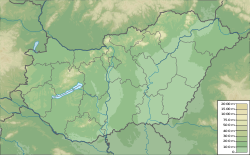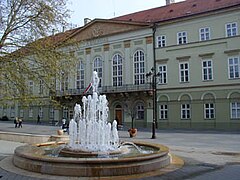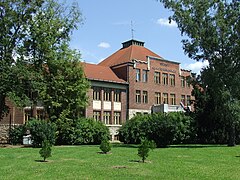Kaposvár
This article may require copy editing for grammar, style, cohesion, tone, or spelling. (September 2021) |
Kaposvár
Ruppertsburg / Ruppertsberg / Kopisch (in German) Rupertgrad (in Slovene) Kapošvar (in Croatian) | |
|---|---|
| Kaposvár Megyei Jogú Város | |
 From the left: City Hall of Kaposvár, County Hall of Somogy, University of Kaposvár, Csiky Gergely Theatre, Cathedral of Kaposvár, Rippl-Rónai Villa and the statue of József Rippl-Rónai | |
| Nickname: City of Flowers | |
| Coordinates: 46°21′50″N 17°46′56″E / 46.36383°N 17.78225°E | |
| Country | |
| Region | Southern Transdanubia |
| County | Somogy |
| District | Kaposvár |
| RC Diocese | Kaposvár |
| Established | 10th century AD |
| Market town status | 1558 |
| Government | |
| • Mayor | Károly Szita (Fidesz-KDNP) |
| • Deputy Mayor | Zsombor Borhi Lajosné Oláh Tamás Dér |
| • Town Notary | Dr Gábor Csillag |
| Area | |
| • City with county rights | 113.59 km2 (43.86 sq mi) |
| Elevation | 153 m (502 ft) |
| Population (2017) | |
| • City with county rights | 64,280[1] |
| • Rank | 13th |
| • Density | 565.89/km2 (1,465.6/sq mi) |
| • Urban | 112,253[2] |
| Demonym | kaposvári |
| Population by ethnicity | |
| • Magyar | 85.6% |
| • Romani | 2.2% |
| • German | 1.1% |
| • Croatian | 0.2% |
| • Romanian | 0.1% |
| • Armenian | 0.1% |
| • Polish | 0.1% |
| • Others | 1.2% |
| Population by religion | |
| • Roman Catholic | 44.7% |
| • Greek Catholic | 0.2% |
| • Calvinist | 5.4% |
| • Lutheran | 1.5% |
| • Jewish | 0.1% |
| • Other | 1.5% |
| • Non-religious | 18.1% |
| • Unknown | 28.5% |
| Time zone | UTC+1 (CET) |
| • Summer (DST) | UTC+2 (CEST) |
| Postal code | 7400, 7451, 7461 |
| Area code | (+36) 82 |
| Patron Saint | Virgin Mary |
| Motorways | M9 (planned) R67 (under construction) |
| Distance from Budapest | 191 km (119 mi) Northeast |
| Airport | Kaposújlak (non-public) Taszár Air Base (military) |
| NUTS 3 code | HU232 |
| MP | Attila Gelencsér (Fidesz) |
| Website | Kaposvár Online |
Kaposvár (Hungarian pronunciation: [ˈkɒpoʃvaːr]; German: Ruppertsburg; see also other alternative names) is a city in the southwestern part of Hungary, south of Lake Balaton. It is one of the leading cities of Transdanubia, the capital of Somogy County as well as the seat of Kaposvár District and of the Roman Catholic Diocese of Kaposvár.[4]
Etymology
The name Kaposvár is derived from the Hungarian words "kapu" and "vár", which translate to gate and castle respectively. Historians suggest that the city's historic landscape, composed of monumental marketplaces as well as ruins and restored versions of century-old castles, makes it a primary destination for Hungarian art and poetry.[5] Variants of the city's name include Turkish: Kapoşvar; Slovene: Rupertgrad; and Croatian: Kapošvar.
Coat of Arms
The shield of Kaposvár features, on a hill of green grass, a castle with a rounded arch port surmounted by three battlements with loopholes.[6] The shield itself is placed over a yellow background to form the official flag of Kaposvár.
Geography
Kaposvár is enclosed by the gentle hills of the outer Somogy area surrounding the Kapos River and by the forests of Zselic. Kaposvár lies 186 km (116 mi) south‐west of Budapest. The city is located approximately 50 km (31 mi) from Lake Balaton (on road 67), 62 km (39 mi) from Pécs (on road 66), 40 km (25 mi) from Szigetvár (on road 67), 92 km (57 mi) from Szekszárd (on road 65) and 72 km (45 mi) from Nagykanizsa (on road 61).
Historically, trade arrived by river and the river became a crossroads reaching into the region. Flood defence mechanisms were established as a result of the numerous hazards imposed by the river valleys of hill regions like the Kapos River.[7] Today, Kaposvár is a developing junction for railways and public roads; transportation to and from nearby towns is convenient, quick and easily accessible. The European Railway line from Budapest towards the Mediterranean, for example, leads through Kaposvár and other Hungarian cities.
History
Pre Hungarian Conquest
According to legend, the city was founded on seven hills and the area had been inhabited by around 5000 BCE. From about 400 BCE, Celtic tribes populated the majority of the area, and from about 9 AD to 107 AD, the city became possession of the Roman Pannonia.[citation needed] Following this, a variety of groups inhabited the area; German and Illyrian tribes, primarily.[citation needed] By 900AD, Slavic and German villages were also found occupying this region. After the Hungarian conquest, the Koppány tribe was said to have settled in Somogy.[citation needed]
Middle Ages
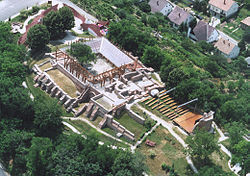
The name of the settlement appeared first in 1009 as "Kapos", in Saint Stephen's memorandum of association, which established the borders of the Roman Catholic Diocese of Pécs. In 1061, Atha (Ottó), the lord lieutenant of Somogy founded a Benedictine monastery - King Salamon and Prince Géza took part in the monastery's consecration. Following the Mongol invasion of Hungary, King Béla IV created a stronger network of castles. Kaposvár's first castle was built during his reign in the 1200s. Despite this, the monastery and considerable settlement around the castle didn't come into existence yet, one reason being because the settlement was avoided by the commercial roads and on the other hand because the different clans fight didn't favour the development[clarification needed]. The rectangular motte castle was reconstructed as a stone castle in the 15th century.
The period of local fighting was ended by military intervention of the Ottoman army. In the decades after the Battle of Mohács, the area was filled by the troops of Suleiman. The Ottomans invaded the castle of Kapos in September 1555 after a five-day siege. It was followed by a 131-year-long Ottoman occupation. During this time, Kaposvár, despite being a small administrative center, functioned as a military camp. Finally, the Habsburg troops conquered the castle of Kapos, and the city and the surrounding area from Ottoman rule in 1686.
Habsburg Rule
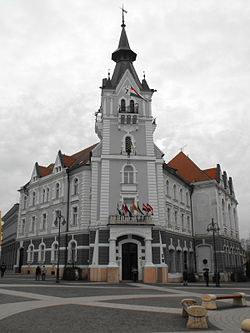
After the Habsburg conquest a church was built and the first guild was founded. The beginning of the 18th century brought suffering and blows to the settlement instead of development.[clarification needed] The Habsburgs in 1702 razed the Castle of Kapos to the ground. Any remaining ruins were further destroying during the Rákóczi's War of Independence.
Some decades later a new country town was built. The resettlement of the city after the destruction was in connection to the name of the Esterházy family and the fortification of its economic and administrative rule. The city got the right to hold markets in 1703, in 1715 the first school was built up, in 1730 there were already 132 houses and a new church was ready in 1748. In 1749, Kaposvár was designated the county seat. In 1750, for good Kaposvár became the chief town of a county. More and more artisans and traders moved into the city and the number of the citizens during six decades doubled by 1780. During the 1800s, the city developed considerably, due to the importance of the railway line between Buda and Zagreb. Kaposvár became an important industrial city.
More importantly, from the 19th century, significant medical and cultural institutions were founded in Kaposvár. The "kis gymnasium" (the predecessor of the present Táncsics Mihály Secondary Grammar School), the Arany Oroszlán Pharmacy (Gold Lion) and the general hospital were built up, and the name of Dániel Berzsenyi can be found among the County Library's readers, which was founded in 1816. The small county town started to become a civic town. The city center evolved with the county hall, the building of the town hall, the church, the Korona Hotel and the Dorottya-house. The National Casino of Kaposvár and the Horse Raiser Company were set up, and visitors to Kaposvár could walk on paved roads. Earl István Széchenyi was elected to the first freeman of the town in 1835.
Revolution and War of Independence (1848–49)
The Hungarian Revolution of 1848 didn't avoid the chief town of Somogy County. The citizens voted for the revolution. Although the kaiser's groups occupied the city for a short time, they couldn't supple the insurrectionist Kaposvár. The local citizens still sacrificed the bell of the church to make cannon. The sheriff of Kaposvár, the later commissary, Gáspár Noszlopy with its territorial army, liberated Somogy County for three months. However the war of independence tumbled and Kaposvár was again under foreign occupation.
Austro-Hungarian Monarchy

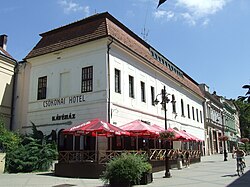
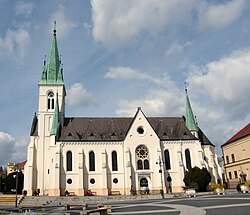

The post office opened, and the country's first soap factory was founded. Thanks to Austrian growth brewer János Donner, a new city district - the present Donner - started to grow on the south side of River Kapos. The local public life bloomed, after the casino the set up of the chorus, and then the first weekly newspaper in 1866, the Somogy started on its way with its editor, the journalist István Roboz. One of Kaposvár's most blossoming times was after the conciliation. Thanks for mostly the railway building: until that time there were railroads only in the winger of the county, and the first engine arrived to Kaposvár in 1872. It opened the possibilities for the artisans and traders and the development of the city's economic life. In the years of 1890 the development of the infrastructure gave new movement to the city's development. Short train ways were built and they made the city for railway interchange. The railway network became wider, there were trying to bring in electricity, a telegraph office was created and they set up telephone connection with Pécs. At the beginning of the 1900s there were already eleven big industrial companies in the city, among them the sugar factory from the autumn 1894, which was then one of the most significant plant in the country, and the MIR Malom grain processing plant. By this time the agricultural character of the city reduced. But there was another, new project: with the growth of the population's number the city became larger and larger. The first important planned city development is in connection with István Németh, who was the mayor of the city between 1895 and 1911. For the citizens their environment became more and more important and thanks for the Kaposvári Szépítő Egyesület (Kaposvári Beautifying Association), the city became then a real "flowered city".
The representatives of the culture had to keep step with the economic development. By that time the city has the right to keep high-school graduation in its secondary grammar school, there was a convent, a seminary and beside other institutions a day-nursery too. The first daily newspaper of the county, the Somogyi Hírlap came out from the printing-house in April 1904. In September 1911 the stone theater of Kaposvár was opened, which was then the country's biggest and most modern theater, where the most popular actors and actresses played. A new cultural trend born, the film: in the first decade of the 20th century there were already three cinemas. Newer and newer cultural and art associations were founded. A number of noted artists settled down there, like József Rippl-Rónai, Endre Ady, István Fekete and Aurél Bernáth.
20th Century
The years of development ended with the start of World War I, in which - like in other important events of Hungarian history - the citizens, the soldiers of Kaposvár took their part. But the war brought hardship and dissatisfaction to the city. In the public life there were strikes and strengthening of left-wing ideas. The ideas of the Revolutions and interventions in Hungary (1918–20) found place in the public life. The first directorium and agricultural association were born here and the plants were socialized. However, the revolution fell and together with the war, the years of terror and the Treaty of Trianon brought a recession which from it slowly recovered from the years of 1930. Although the role of the railway transport diminished, bus transport started and in 1929 the airport was built in Taszár. From an industrial city Kaposvár became a commercial and administration center and the transformation of the cityscape reflected this change. It didn't just have flowers but was a clean, pleasant, civic town with restaurants, cafés and active cultural life. Thanks to József Adorján, Ferenc Csik and a number of Olympic sportsmen the world got to know the city's sportlife.
The national policy darkened more and more, the "happy peacetimes", the left-wing ideas and later the wind of the World War II reached the city. Almost one thousand citizens died or disappeared during the fights. In 1944 the city was twice under foreign occupation. In March the German soldiers filed in Kaposvár. The Jews were deported and most of them were murdered in Auschwitz. The frontline arrived here on 2 December when Soviet troops replaced the Germans.
The life could start fast in the city because the fights didn't cause remarkable destruction. Kaposvár always said to be an "insurrectionist" city and it chose again the policy of restart. The parties formed, like the Communist Party, but the Country Party had the biggest side. After the communist received the power the socialisations finished and the new kind of industrial expansion started, the socialist industrialisation. Its result was for example the textile factory, meat plant, electricity factory. But the small industries disappeared. In 1956 Kaposvár joined the revolution but on 4 November the soviet tanks clunked through the city's streets: the fall of the revolution and the sanctions had a lot of victim in Kaposvár. Between them the famous born of Kaposvár, the revolution's martyr prime minister, Imre Nagy.
The chief city of the county woke up hardly after the flop. In the next decade the development of the industry and the flat construction started. From 1970 new subtopias built. The city's administrative border flared: in 1950 Kaposszentjakab, in 1970 Kaposfüred and Toponár and in 1973 Töröcske joined the city. In 1971 the training-school and the agricultural technical institute became college. Notable contributors to the fields of science and culture include: the Archives of Somogy County, the Csiky Gergely Theatre, the Béla Vikár Choir, the Somogy Dance Group, and the Berzsenyi Company.
The crisis of the 1980s, and the stop of the city's development made necessary changes. In the end of the decade - like so many times during its history - Kaposvár stood to the top of reforms. The maverick organisations were funded and a memorial tablet was put on Imre Nagy's house, as the symbol of new times. In 1990, Kaposvár became urban county and in 1993 an episcopal seat.
21st Century
Today Kaposvár - with its university, education system, and thousands of students - is a real school city. With the well-kept plazas, streets, and colourful flowerbeds it is the city of flowers. With its rippling wells it is the city of waterworks. With its lively cultural life, rich art programmes it is the city of festivals and the city of painters. With its wonderfully reborn downtown with the feeling of peaceful, Mediterranean atmosphere, the chief town of the county has become a real European city.[8]
Main Tourist Sights
- City Hall of Kaposvár
- Cathedral of Kaposvár
- County Hall of Somogy
- Rippl-Rónai Museum - one of the biggest museums of Hungary
- Rippl-Rónai Villa - the house of the painter József Rippl-Rónai
- Csiky Gergely Theatre - one of the biggest theatres in Hungary
- Dorottya House
- Vaszary Gallery - former Gallery of Somogy
- Palace of Culture of Kaposvár (Szivárvány Kultúrpalota) - the home of the Kaposfest[9] every August
- Árpád Együd Cultural Community Centre
- Archives of Somogy County
- Sport Museum of Somogy County
- St. Donat Chapel (Baroque, early 18th century)
- Ruins of Zselicszentjakab Abbey (Romanesque and Gothic)
- Arany Oroszlán Pharmacy (Gold Lion)
- Former Convent - now it is the Roman Catholic High School, Elementary School and Primary Art School and the headquarters of the Roman Catholic Diocese of Kaposvár
- Stadion Kaposvár Rákóczi
- University of Kaposvár
- Lake Deseda
- Virágfürdő (Flower Spa and Waterpark)
Demographics
| Year | Pop. | ±% |
|---|---|---|
| 1850 | 4,638 | — |
| 1890 | 12,544 | +170.5% |
| 1900 | 18,630 | +48.5% |
| 1910 | 24,572 | +31.9% |
| 1920 | 30,096 | +22.5% |
| 1930 | 33,226 | +10.4% |
| 1941 | 33,515 | +0.9% |
| 1949 | 33,535 | +0.1% |
| 1960 | 43,428 | +29.5% |
| 1970 | 60,937 | +40.3% |
| 1980 | 72,374 | +18.8% |
| 1990 | 71,788 | −0.8% |
| 2001 | 68,697 | −4.3% |
| 2011 | 66,245 | −3.6% |
| 2019 | 61,441 | −7.3% |
Kaposvár is the most populous city in Somogy County and the second most populous city in Southern Transdanubia after Pécs.
The majority of its population is Hungarians (85.6%) according to the 2011 census. The largest ethnic group is the Roma (2.2%), the second largest are the Germans (1.1%) and third are the Croats (0.2%).[3]
Religious affiliation of the citizens show a significant Catholic (Roman Catholic (44.7%) and Greek Catholic (0.2%)) and considerable Calvinist (5.4%) and Lutheran (1.5%) communities. 18.1% are Non-religious.[3]
Economy
There are lot of industrial companies in the city.
The Austrian house construction company Wolf System,[10] the Hungarian agricultural company KITE[11] and the Turkish textile producer Metyx[12] operate a production facility in the city.
The Hungarian Tornyos Distillery,[13] the Hungarian machine manufacturer Luckympex,[14] the Hungarian bus factory Kapos,[15] the Hungarian gas receiving unit producer Peró Gáz,[16] the Hungarian-German sugar producer Magyar Cukor Manufaktúra[17] (partly owned by Pfeifer&Langen),[18] the Hungarian metal producer Kapos Galván,[19] the Hungarian reagent producer Galvanochem,[20] the Hungarian metal producer Kapos Atlas,[21] the Hungarian steel structure manufacturer Török,[22] the fuse manufacturer Fusetech[23] (owned by the French Mersen), the starch manufacturer Hungrana[24] (owned by the Austrian Agrana and the British Tate & Lyle), the sugar producer Magyar Cukor[25] (owned by Agrana), the Hungarian roof structure manufacturer Profi Tető,[26] the Hungarian meat producer Kométa 99,[27] Hungarian plastic producer KAPOSPLAST,[28] the Hungarian metal manufacturer Lakics,[29] the Hungarian gear manufacturer Szabó,[30] the Hungarian door and window producer Alfa-Tóth,[31] the Hungarian Videoton Elektro-Plast[32] (owned by Videoton), the Hungarian cheese producer Fino[33] (est. 1889) and the Hungarian fuse manufacturer KVGY (Kaposvári Villamossági Gyár, est. 1967)[34] are based there.
Politics
The current mayor of Kaposvár is Károly Szita (Fidesz-KDNP).
The local Municipal Assembly, elected at the 2019 local government elections, is made up of 18 members (1 Mayor, 12 Individual constituencies MEPs and 5 Compensation List MEPs) divided into this political parties and alliances:[35]
| Party | Seats | Current Municipal Assembly | |||||||||||||
|---|---|---|---|---|---|---|---|---|---|---|---|---|---|---|---|
| Fidesz-KDNP | 13 | M | |||||||||||||
| Opposition coalition[a] | 4 | ||||||||||||||
| Winegrovers | 1 | ||||||||||||||
Sports
Kaposvár is one of the "National City of Sport" in Hungary. The most popular sports in the city are football, volleyball and basketball. There are a lot of champion team in the city. The most famous sport team is the Kaposvári Rákóczi FC. Their home stadium is the Stadion Kaposvár Rákóczi. The biggest sporting event in the city is the Youth Football Festival[36] every summer.
Notable Residents
Twin Towns – Sister Cities
 Bath, England, United Kingdom
Bath, England, United Kingdom Cần Thơ, Vietnam
Cần Thơ, Vietnam Darkhan, Mongolia
Darkhan, Mongolia Glinde, Germany
Glinde, Germany Koprivnica, Croatia
Koprivnica, Croatia Miercurea Ciuc, Romania
Miercurea Ciuc, Romania Rauma, Finland
Rauma, Finland Saint-Sébastien-sur-Loire, France
Saint-Sébastien-sur-Loire, France Schio, Italy
Schio, Italy Tver, Russia
Tver, Russia Üsküdar, Turkey
Üsküdar, Turkey
Partnerships
Kaposvár also cooperates with:[38]
Gallery
-
The city centre
-
Palace of Finances of Kaposvár
-
The County Hall of Somogy and the Rippl-Rónai Museum
-
A statue in the city centre
-
The Rococo Maria Column is one symbol of the city
-
Monument of the Hungarian Revolution of 1956
-
Dániel Berzsenyi Elementary School
-
Temesvár street
-
House of József Rippl-Rónai
See also
References
- ^ 2017. év: Magyarország állandó lakosságának száma az év első napján (2017. január 1.) XLS táblázat. Nyilvantarto.hu (Hozzáférés: 2017. április 6.)
- ^ Eurostat, 2016
- ^ a b c d KSH - Kaposvár, 2011
- ^ "Kaposvár, Kaposvár, Somogy, Hungary - City, Town and Village of the world". en.db-city.com. Retrieved 2021-10-02.
- ^ "Kaposvar | History & Facts". Encyclopedia Britannica. Retrieved 2021-09-29.
- ^ "National and historical symbols of Hungary". www.nemzetijelkepek.hu. Retrieved 2021-09-30.
- ^ Lóczy, Dezső, Dénes, Jozsef (July 2013). "Groundwater flooding hazard in river valleys of hill regions". Hungarian Geographical Bulletin. 2: 157–174 – via ResearchGate.
{{cite journal}}: CS1 maint: multiple names: authors list (link) - ^ "Kaposvár's history". Retrieved 2012-09-16.
- ^ Kaposfest Archived 2013-06-07 at the Wayback Machine
- ^ Wolf System
- ^ KITE Kapcsolat
- ^ Metyx
- ^ Tornyos Disztillery
- ^ Luckympex
- ^ Kapos
- ^ peró Gáz
- ^ Magyar Cukor Manufaktúra
- ^ Százmilliót költött fejlesztésre a kaposvári cukor manufaktúra kft. - April 22, 2015
- ^ Kapos Galván
- ^ Galvanochem - Bemutatkozás
- ^ Kapos Atlas
- ^ Török - Bemutatkozás
- ^ Fusetech - Rólunk
- ^ Hungrana
- ^ Magyar Cukor
- ^ Profi Tető
- ^ Kométa 99
- ^ KAPOSPLAST
- ^ Lakics
- ^ Szabó
- ^ Alfa-Tóth
- ^ Videoton Elektro-Plast
- ^ Fino
- ^ KVGY
- ^ "Városi közgyűlés tagjai 2019-2024 - Kaposvár (Somogy megye)". valasztas.hu. Retrieved 2019-11-24.
- ^ Youth Football Festival
- ^ "Kaposvár testvérvárosai". otthon.kaposvar.hu (in Hungarian). Kaposvár. Retrieved 2021-03-24.
- ^ "Kaposvár partnervárosai". otthon.kaposvar.hu (in Hungarian). Kaposvár. Retrieved 2021-03-24.
- Notes




